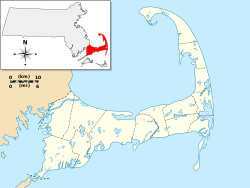John and Mary Waterman Jarves House | |
 The house in 2013 | |
| Location | Sandwich, Massachusetts |
|---|---|
| Coordinates | 41°45′30″N70°29′46″W / 41.75833°N 70.49611°W |
| Built | 1857 |
| Architect | Kirby, Charles Kirk |
| Architectural style | Italianate |
| Part of | Jarvesville Historic District (ID10000787) |
| NRHP reference No. | 02000903 [1] |
| Significant dates | |
| Added to NRHP | August 30, 2002 |
| Designated CP | September 23, 2010 |
The John and Mary Waterman Jarves House is a historic house at 3 Jarves Street in Sandwich, Massachusetts. The 2+1⁄2-story Italianate wood-frame house was designed and built by Charles Kirk Kirby in 1857. It was built for John Jarves, founder of the Cape Cod Glass Works, one of the major business in 19th century Sandwich. He was the son of Deming Jarves, founder of the Boston and Sandwich Glass Company. [2]
The house was added to the National Register of Historic Places in 2002, [1] and included in the Jarvesville Historic District in 2010. [2]



